With the rapid development of digital creation, external SD cards have been an important tool for people to store a great amount of different content. Under such a trend, some Android phones offer the option of using an external SD card to expand the storage. Then here comes a problem for some people: how to read my external SD card on my phone?
In fact, an SD card reader for Android devices can help you fix this. But how to choose from all those readers? Look through this post and you will learn about how to use and select an SD card reader to access and read external SD cards on Android phones.
Overview of the Top 7 Android SD Card Readers
Each Android SD card reader has its specific features, and only the reader with the function you need can help you view your files successfully. The following table can help you get a rough idea of those readers.
| Brand | Media Type | Compatible Device | Transmission Rate | Price |
| UGreen | MicroSD, Memory Stick, Compact Flash, SD Card | Personal Computer, Laptop, Switch, Smartphone | 5 Gbps | $23.99 |
| Vanja | MicroSD, MMC, RS-MMC, MicroSDXC, SDXC, SDHC, MicroSDHC, TF Card, UHS-I Card, SD Card | Laptop, Personal Computer, Smartphone | 480 Mbps | $7.99 |
| Unitek | MicroSD, MicroSDXC, MicroSDHC, SDXC, SDHC, SD Card | Smartphone, Laptop, Tablet, PC | 5 Gbps | $16.99 |
| BoneView | SD Card | Camera | / | $19.95 |
| COASD | MicroSD, MMCmicro, MMC, RS-MMC, MicroSDXC, MicroSDHC, SDXC, SDHC, UHS-1, SD Card | Tablet, Smartphone | 480 Mbps | $6.98 |
| Anker | MicroSD, MMC, RS-MMC, Memory Stick, MicroSDXC, MicroSDHC, MiniSD, SDXC, CompactFlash, SDHC, UHS-1, SD Card | Laptop, Personal Computer | 5 Gbps | 14.99 |
| Transcend | MicroSD, MicroSDXC, MicroSDHC, SDXC, SDHC, UHS-1, SD Card | Printer | 5 Gbps | $8.96 |
Detailed Introduction to Best 7 SD Reader for Android
There are a pretty large number of SD card readers in the market currently. However, not all type of reader is suitable for Android phones and does well in reading an external SD card. Professional Android SD card readers can meet these requirements much better.
Here we list seven choices of SD card readers that apply to Android phones for reference:
UGreen SD Card Reader
The UGreen SD card reader is an all-in-one product that applies to multiple cards. There are four card slots on it respectively for SD, Micro SD, CF, and MS so it can support most standard memory cards, such asSD, SDXC, SDHC, Micro SD(TF), Micro SDXC, Micro SDHC, UHS-I, Compact Flash, and Memory Stick cards.
What’s more, the reader can read and write four different memory cards simultaneously and it has a plug-and-play style, without drivers needed. The USB 3.0 device port reaches up to 5 Gbps in transmission rate. These features allow you to save more time and have no need to worry about formats. You can easily use the card reader with laptops, computers, and Android phones.
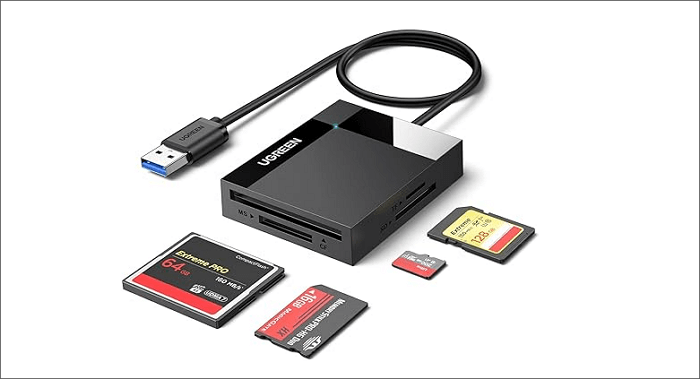
Vanja 3 in 1 SD Card Reader
The Vanja card reader sets the USB 2.0 plug, Micro USB plug, and USB C plug in one. (To learn more about the USB connector standard please click here.) Therefore, it boasts good compatibility with all USB C devices and tablets and Android smartphones supporting OTG functions.
You can play music or videos from external memory without occupying space on your Android phone. Meanwhile, the card reader is appropriate for laptops, computers, and smartphones and can support a wide range of memory cards including SDXC, SDHC, SD, MMC, RS-MMC, Micro SD, TF, Micro SDXC, Micro SDHC, and UHS-I cards.
It is also a plug-and-play device so you do not need to install additional software.
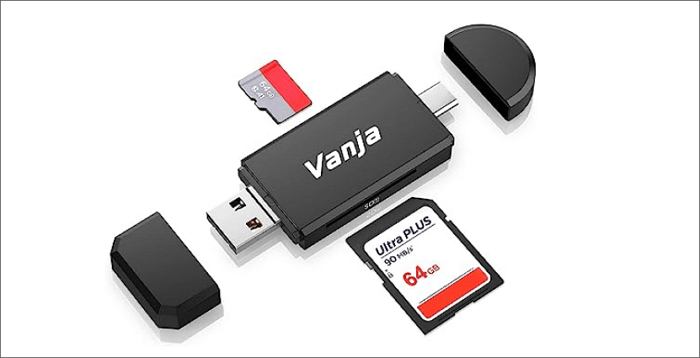
Unitek 3-in-1 USB-C Reader
The Unitek 3-in-1 USB-C reader can read three cards simultaneously and is compatible with MicroSD, MMC, MicroSDXC, MicroSDHC, SDXC, CompactFlash, SDHC, UHS-1, and SD Card. With the 5 Gbps transmission rate, it can realize fast and reliable file transfers with devices like smartphones and tablets.
Furthermore, its cover is made from aluminum alloy, prolonging its service life. The plug-and-play design also makes it pretty easy and convenient to use.

BoneView SD Card Reader for Android
The BoneView SD card reader is specially designed for people who are going to be in the wild and thus it can work well anywhere in the woods with no need for a network, cell services, or batteries.
With the plug-and-play setting, you can easily use the reader to view, play, save, share, and delete photos and videos from camera memory cards on any smartphone and tablet. It supports all the latest Type-C Android phones.
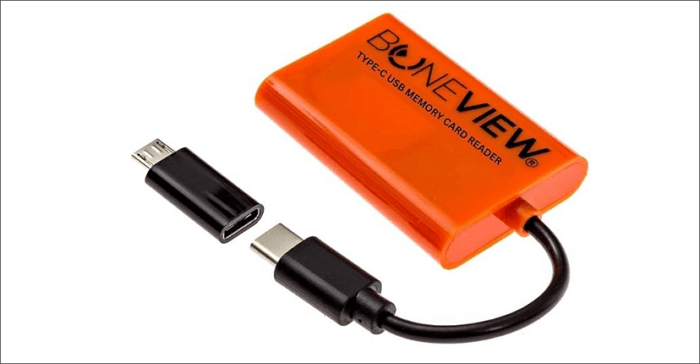
COASD Card Reader
The COASD card reader is designed for Android phones that cannot operate on USB-C. Instead, it can be plugged into a micro USB socket on a phone and a USB-A port on a laptop or computer.
The card reader is compatible with all tablets and Android phones as long as they support the micro-USB tech. It is suitable for all standard SDHC/SDXC and micro SD/micro SDHC/micro SDXC formats.
However, this product is not friendly to memory cards over 64 GB in size. The biggest reason is that the power current that can be provided by phones is rather limited.
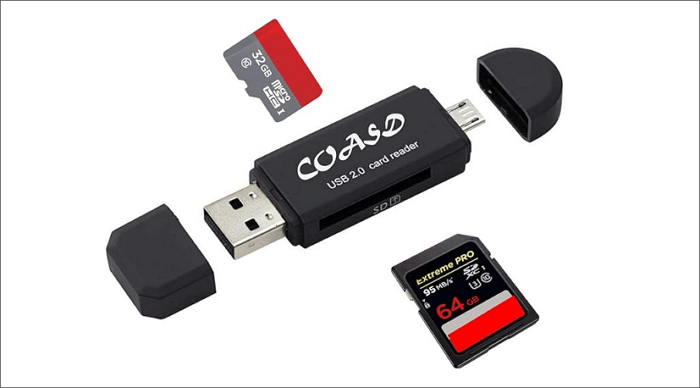
Anker 8-in-1 Portable Card Reader
The Anker 8-in-1 portable card reader will not directly read on your Android phone. Rather, you should take your device’s micro SD card out, put it in this card reader, and then connect it to a laptop or computer so that you can extract the files stored externally on your Android phone.
You can use it with MicroSD, MMC, RS-MMC, Memory Stick, MicroSDXC, MicroSDHC, MiniSD, SDXC, CompactFlash, SDHC, UHS-1, and SD cards. This card reader can read and write on two cards at the same, which significantly saves you time.
Moreover, as it has employed the USB 3.0 technology, the data transmission rate is able to reach the way up to 5 Gbps.
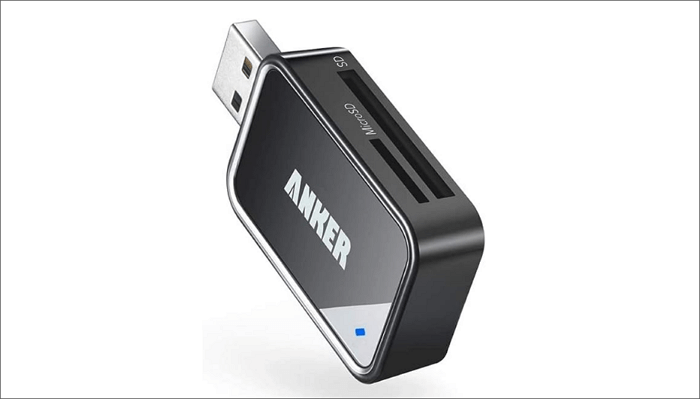
Transcend TS-RDF5K Card Reader
The Transcend card reader is a superspeed USB 3.1 interface, but it can be backward compatible with USB 2.0 as well. Though a little larger, it can be used with any Android phone on the market at present. The product supports SDHC (UHS-I), SDXC (UHS-I), microSD, microSDHC (UHS-I), and microSDXC (UHS-I).
One good point is it comes loaded with data recovery software, which offers convenience and help when your SD card or micro SD card has something wrong but you want to recover its lost data.
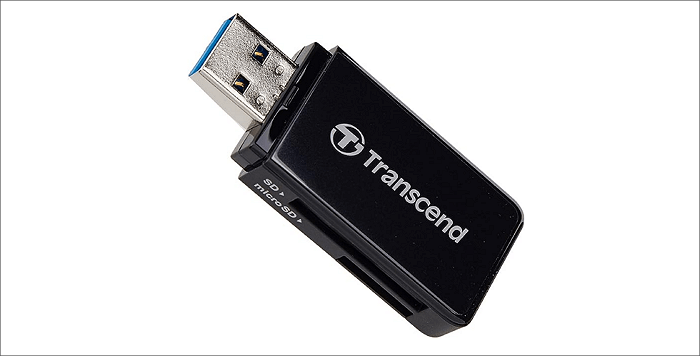
Conclusion
In conclusion, all those 7 SD card readers for Android phones mentioned in this post will help you access your files conveniently. Whether you need to transfer the data efficiently or expand the storage options, those memory card readers can always be practical. Thus, you can choose the most suitable one according to your situation.
FAQs About Smartphone SD Card Reader
As there are so many smartphone models on the mobile phone market, it’s not an easy task to find the most suitable SD card reader for your device. No worries. The FAQs below will answer some common questions about this topic and help you access your file successfully.
How to Recover Deleted Files From an SD Card?
There are many optional data recovery software that supports restoring lost files on SD card. ONERECOVERY is one recommendable SD card recovery tool that can work on both Mac and Windows.
Here is the tutorial for using this software:
Step 1. Connect the SD card to your PC or MacBook. And then launch ONERECOVERY on the same device.
Step 2. Choose a folder on your SD card for the data recovery.
Step 3. Start the data scanning process. ONERECOVERY allows you to choose from Deep Scan and Quick Scan.
Step 4. Choose the files you want to retrieve from the scan results. Then, click on the “Recover” button to get your files back.
What is the Difference Between an SD Card Reader and an SD Card Adapter?
The SD card adapters are also widely used in our daily lives, and people usually utilize them to convert data between 2 different devices. However, sometimes many people may be confused about this question: Are SD cards and adapters the same?
Of course, the answer is no. This part will offer a detailed comparison between these 2 tools.
| Differences | SD Card Reader | SD Card Adapter |
| Function | An access interface that reads and writes data between an SD card and a host device. | A port converter that enables users to connect an SD card to a device with a different type of memory card slot. |
| Price | Usually under $25. | Usually under $20. |
| Appearance | Mostly small and portable. | Mostly small and portable. |
In a word, the most obvious difference between SD card readers and adapters lies in their functions. The former serves as an interface between two devices to access and read data while the latter works like a bridge to build a compatible connection between devices with different port types.
How to View SD Card Files on Android Phones?
A professional SD card reader is a good option for accessing the external SD card on your Android phone. It is a small and portable device that enables you to read and transfer data from an SD card to other devices like a computer and smartphone.
Here’s how to use an SD card reader for Android phones to access and read the external SD card:
1️⃣ Insert the SD card into the corresponding slot on your Android phone.
2️⃣ Plug the SD card reader into your phone’s USB port. Then the device will automatically recognize the SD card.
3️⃣ Go to the File Manager app on your Android device. It is usually pre-installed, but if you do not have it, you can download it from the Play Store.
4️⃣ Navigate to the home screen or main page of the File Manager.
5️⃣ Locate an option labeled “External Storage” or “SD Card”, which depends on your specific Android device, and tap on it to access the SD card that was inserted just now.
You May Also Be Interested in:
Why Did My SD Card Suddenly Stop Working
How to Recover Deleted Files from SD Card on Mac
How to Fix Unreadable SD Card and Recover Data
How to Format SD Card Without Losing Data
Vanessa is a professional editor with a strong foundation in computer information technology. Since graduating, she has dedicated her career to create content in IT fields. In the past three year, she has accumulated sufficient knowledge in data recovery, computer problems troubleshooting and application of multimedia software.
She has been trying her best to bridge the gap between complex technical concepts and accessible, reader-friendly content.







